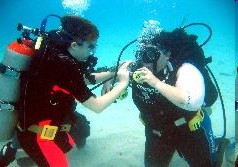The Independence II made a run out the SS Carolina early Sunday morning. The plan was to stay overnight. To make a long story short, NOAA’s favorable forecast on Saturday night, was revised when we got out there. This cut our trip short, but we still got in some good dives.
Upon arrival, Captain Dan circled the wreck a few times as his depth finder readings did not look right to him. Bill and I jumped in to find the line right beside the wreck, but the wreck didn’t look right. Over the winter, the wreck has collapsed. I recall the starboard side standing some 20-30 ft off the bottom. Now it lay almost flat. Bill was much more familiar with the wreck, and was taken back by what he saw. I guess this explains why Capt Dan was circling.Inflatable Water Slide Bill was unable to find his favorite tie-in spot, so we grabbed the closest spot that looked good. One Ling cod was either very interested in what we were doing, or very pissed that we were digging in his hole. Either way he was never more than a few inches from us during the operation.
Vis on the bottom was a clear 50ft, but dark. We tied off a our beacons. Bill signaled “let’s go swimming”, and off we went. Before long we saw some china in the sand, and started to sift through them. It turned out to be mostly shards, but Bill was able to pull out a small ash tray. I had my hands on a large piece of porcelain, but was unable to get it out from under the decking. I was not sure what it was, but it was big, and the hole I was working in was too small for it to move. My planned bottom time was running short, so I signaled Bill and headed back to the line.
Looking at my computer during the ascent, I noticed something I hadn’t before. Its 42 degrees! It’s August, how can it be 42 degrees? That can’t be right, check the backup. Yup, 42 degrees! I could still see the beacons at the first deco stops start at 160, but the thermocline starts back at 50 ft. This was going to be friken COLD. There was little to no current on the line, but the cold started to get really bad. Our work load had prevented us from feeling it on the bottom, but now it started to set in. My body was warm enough, but at that depth, Neoprene gloves lose most of their insulation. Mine are 7 mil, but just looking at them, I can tell they are compressed.
At 70 ft the temp jumped up to 44, and I can actually say it felt good. At this point I was in the surface water which had to be 100+ ft of visibility. I could see Bill’s bubbles rising out of the cloudy layers below. At 50 ft the temp rose to 52 degrees, then at 30 it rose to 78. Now I’m sweating in my suit, but it felt much better. I was a little startled when a large Mula-mula swam right by me on the line. He looked at me for a moment, then swam toward Bill. Due to the cold and workload, I stayed a few extra minutes at the 20 ft stop. I could see Bill as he passed through the thermocline some 70 ft away.
On the surface the seas had turned to 4-6, and the forecast was to get worse tonight. Some of the other divers had passed me on the line. When Bill surface, he and Captain Dan discussed the changes in the wreck at length. Dan geared up and went in. The other passengers came up commenting on the cold. Discussions of numb fingers, and cutting bottom time short. Everyone mentioned the change in the wreck. There were descriptions of large lobsters, but no one wanted to grab them with their cold hands. I guess if they had delayed their dive until we surfaced, they could have switched to dry gloves. Dan had checked out some spots of interest, and came up with a brass shirt hanger.
Other than the cold, the conditions had been fantastic! When I jumped in to pull, the sun was now higher in the sky, and the wreck came into view shortly after the beacon. I didn’t really need my light. If the surface conditions were better, I’d love to have gotten more dives in. This is a great wreck with lots to see.
 This is a another common question along with: How do you learn to dive? How long does it take?
This is a another common question along with: How do you learn to dive? How long does it take?